The following is a guest post by Monica Stott. If you’d like to guest post on Go Backpacking, please read our submission guidelines.

Anemonefish protecting their home
Learning to scuba dive is often one of the highlights during a backpacker’s trip abroad. Discovering a new country from above the surface of the sea is fantastic, but discovering the world that lies beneath us is a whole different experience.
SE Asia continues to be one of the most popular places for budget travellers to learn to dive. You can take your pick from a multitude of white, sandy beaches with clear, warm water. There is a fantastic array of accommodation to suit all budgets and a bustling night life that can be as action packed as you please.
And if that isn’t enough, the underwater world in SE Asia has some of the richest reefs on earth and is home to 76% of the worlds coral species and 6,000 species of fish.

USAT Liberty shipwreck, Bali
PADI Courses
Most people learn to dive with a 4-day Open Water course from a PADI certified dive school. PADI are world renowned due to their high standards and safety is their first priority.
You will begin in the classroom, learning the necessary theory before you’re taught about your equipment. Your first experiences in the water will be in ‘confined water’ which is usually a swimming pool but can also be done in shallow, calm sea. Breathing underwater for the first time is a fantastic feeling and while you adjust to the strange sensation you will also practice basic skills such as clearing water from your mask without re-surfacing, sharing air with a buddy diver and controlling your buoyancy under the water.
After 5 confined water dives you will be feeling confident and ready to move into ‘open water’. You will finally have the chance to explore what the sea has to offer and also practice the skills that you learnt in the pool. Within 4 dives in the ocean you will be a qualified Open Water Scuba Diver!
Top 10 Tips for Learning to Dive in Southeast Asia
So you’re ready to explore the expansive underwater playground that SE Asia has to offer? Check out these tips for learning to dive in Southeast Asia to ensure you find the right school and get the most out of your diving experience:
- When considering where to learn to dive, check the weather. The weather varies considerably throughout SE Asia and certain dive areas may be closed for a few months during the monsoon season.
- Some great places to learn to dive in SE Asia are Ko Tao, Phuket, Bali and The Gili Islands but while you’re learning, somewhere with calm water and decent instructors are your main priorities and virtually all dive centres offer PADI courses.
- Become a confident snorkeler. If you are nervous about diving, spend a day snorkelling. Once you are confident swimming with fins, swimming in currents, diving below the surface and clearing you mask of seawater and fog, learning to dive is an easier and calmer experience.
- Before paying for your course, take a Discover Diving introduction course. Diving isn’t for everyone so this short experience will allow you to make up your mind before committing to an expensive course.
- When choosing your school, find the right balance between popular and overcrowded. Legally, 8 is the maximum number of students in an Open Water PADI course but the fewer the better, particularly if you are a nervous diver. Too few would leave me dubious about the quality and reputation of a company but you will generally know if you feel comfortable with a dive instructor as soon as you meet them. So shop around, talk to the instructors and fellow divers in the area.
- Don’t choose a school based on price. Prices rarely fluctuate dramatically as dive shops usually agree on a standard price. Beware if one school is considerably cheaper than another.
- Ensure you are comfortable with your equipment. Most equipment comes in a wide variety of sizes and some dive shops even have different brands available, so don’t be afraid to swap and change until you find the right fit as it makes your diving experience more enjoyable.
- Learn at your own pace. All instructors are remarkably calm and patient and will encourage you to go as slow as you need to. You need to feel confident and comfortable before you move onto the next step.
- You need to be relatively fit and healthy to dive. If you are concerned about your health, arrange for a dive medical with a doctor. This is also necessary for anyone planning on taking their diving qualifications further than Open Water such as an Advanced PADI course.
- Don’t drink too much the night before you dive. It’s common to go for drinks with your new dive buddies after a dive but there’s nothing worse than diving with a hangover so stay away from the whiskey buckets!
___________
About the Author: Monica Stott caught the travel bug when she was just 10 years old and is currently on a 2 year trip around the world. You can read her tales at: TotalTravelBug.com or on Twitter @TotalTravelBug.
This post was written by a guest contributor. Please reference the author's byline in the post above for more information. If you would like to guest post on Go Backpacking, please read our submission guidelines. For information on advertising opportunities, go here.
Planning a trip? Go Backpacking recommends:
- G Adventures for small group tours.
- Hostelworld for booking hostels.

Lauren Beach
Monday 14th of February 2011
I want to get to SE Asia and learn how to dive now! Awesome article!
Daybarnes
Saturday 12th of February 2011
Amazing pics and great information, SE Asia sounds the place to go for diving.
ryan powell
Saturday 12th of February 2011
iv not long done asia it was really awesome, would love to try bali one day! good advise.
Daybarnes
Saturday 12th of February 2011
Amazing pics and great information, SE Asia sounds the place to go for diving.
Ben
Saturday 12th of February 2011
Great tips. I recently completed the Open water course on Koh Tao and loved it. Read my blog on the course here: http://roundtheworldtraveler.com/place/thailand/koh-tao-open-water-diving-course/